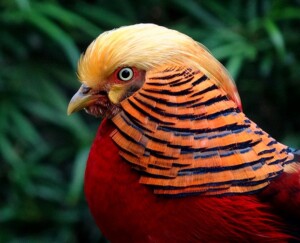Changes to the British List (21 May 2024)
The British Ornithologists’ Union Records Committee (BOURC) has changed the category of a species on the British List.
The following species has been changed from Category C1E* to Category C6E* of the British List:
 Golden Pheasant Chrysolophus pictus
Golden Pheasant Chrysolophus pictus
Photo (right): Golden Pheasant | Bjørn Christian Tørrissen CC BY-SA 3.0 Wikimedia Commons
Species on Category C of the British List are those that derive from translocation(s) (i.e. human-mediated movement and release) resulting in the establishment of self-sustaining population or populations within Britain, and vagrants from a self-sustaining population outside of Britain which have derived as a result of translocation(s). Golden Pheasant Chrysolophus pictus was included in Category C at the inception of this category in the 6th Report of the BOURC in 1971 (Ibis 113: 420-423). In 2005 Category C was subcategorised into six subcategories C1-C6 (Ibis 147: 803-820), and Golden Pheasant was included in C1: ‘Naturalized translocated species – species that have occurred only as a result of translocation(s)’.
In 2023 a study exploring the current status of Golden Pheasant in Britain was published surmising that ‘there is no evidence to suggest that Golden Pheasants persist in the UK as a self-sustaining population’ (Biological Invasions 25: 3341-3351). The BOURC considered the conclusions drawn by the authors of this work and agreed; accordingly Golden Pheasant is now moved from C1 to C6: ‘Former naturalized species – species formerly placed in C1 whose naturalized populations are either no longer self-sustaining or are considered extinct’ where it joins the congeneric Lady Amherst’s Pheasant C. amherstiae.
This decision will be published as part of the BOURC’s 57th report due to be published in Ibis in January 2025. Upon publication of this change, the British List remains at 634 species (Category A = 616; Category B = 8; Category C = 10).


